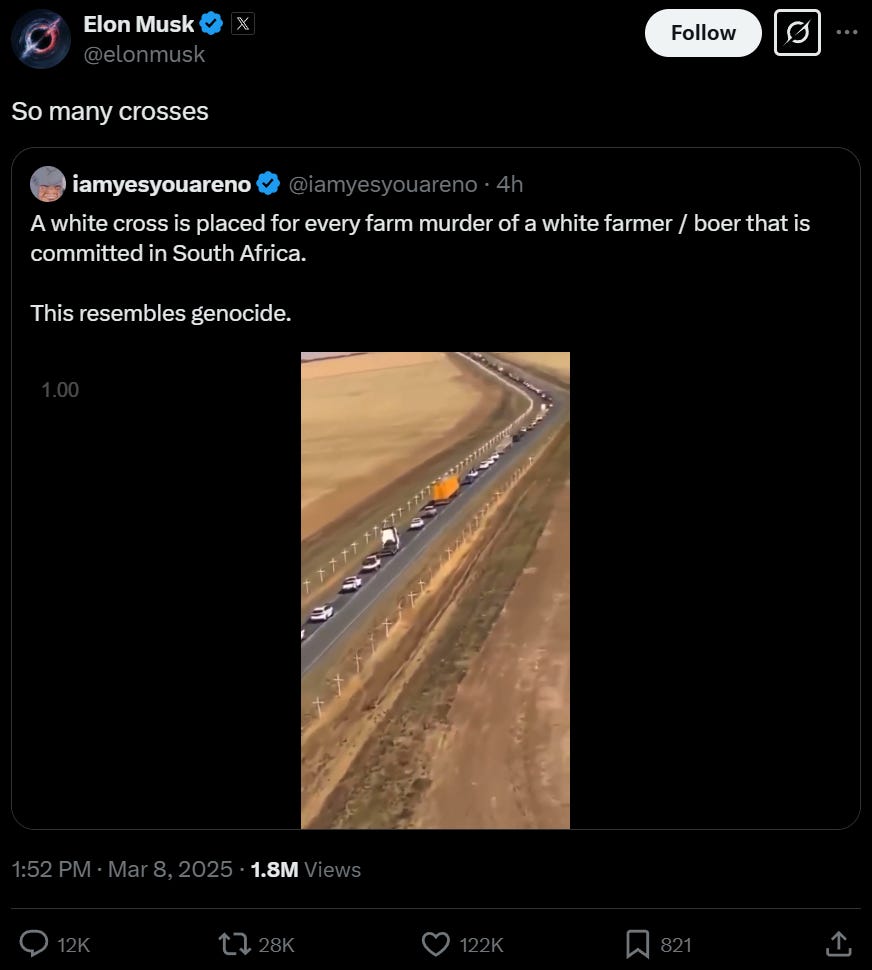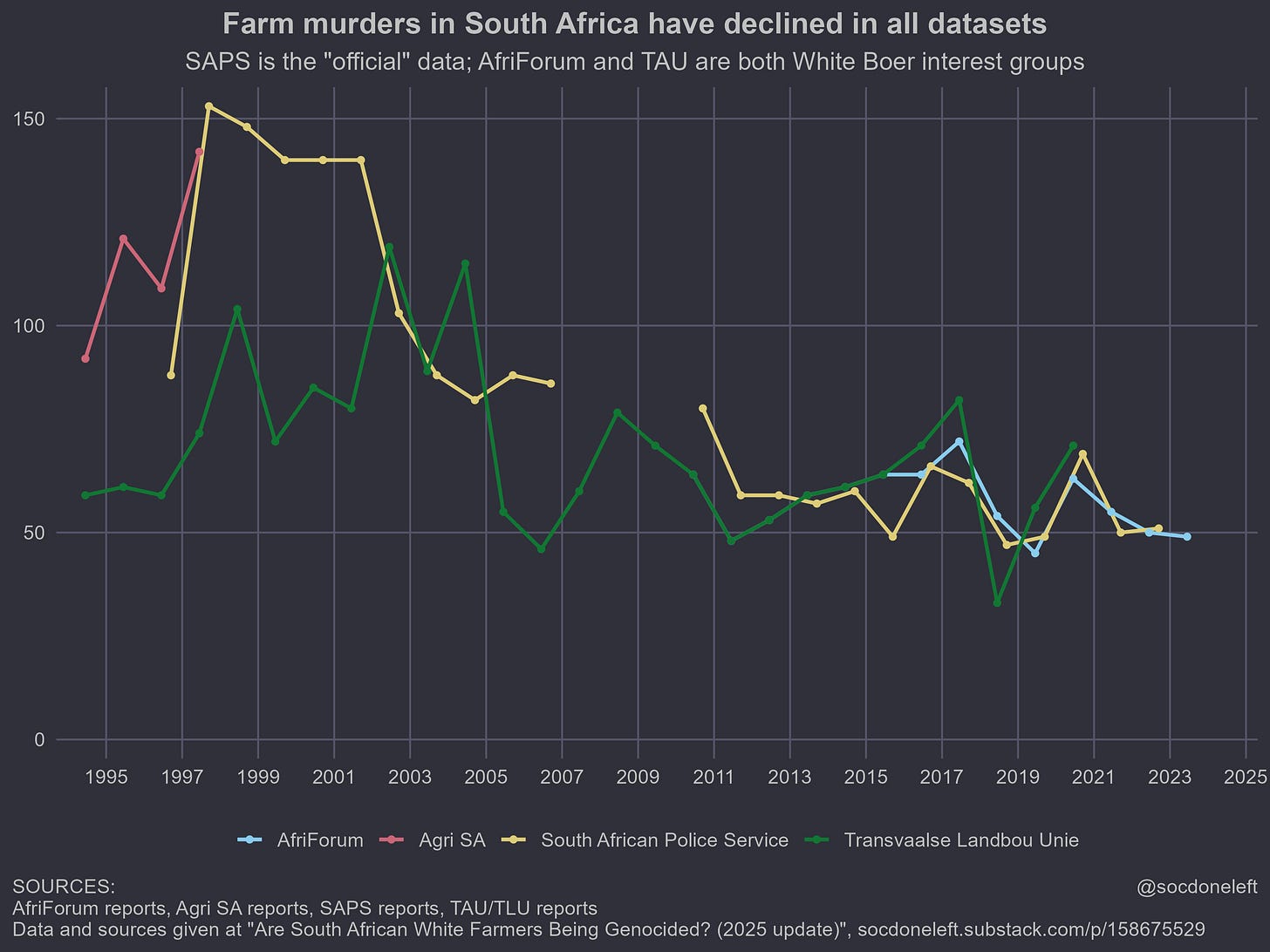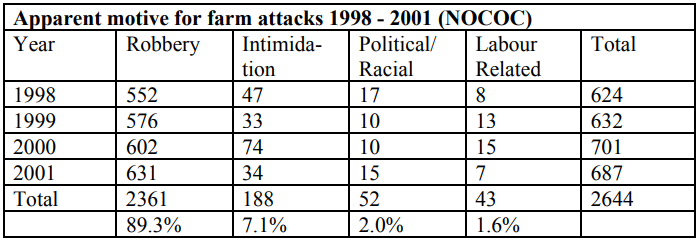One month ago, American oligarch and White nationalist Donald Trump signed Executive Order 14204, which halted all aid to South Africa and claimed that White Afrikaners faced “disproportionate violence” as “racially disfavored landowners”.
Earlier today, American oligarch and White nationalist Elon Musk boosted a neo-Nazi account which claimed that White farmers in South Africa are suffering a genocide:
They’ve both pushed the “South African white farmer genocide” idea for years. In 2023, Musk said that South Africa’s government was “openly pushing for the genocide of white people”. In 2018, Trump asked the State Department to investigate “the large scale killing” of “white farmers”.
In reality, the “South African white farmer genocide” idea is bullshit. Three reasons:
Farm attacks and murders have substantially dropped, not risen.
The farm murder rate is similar to the non-farm murder rate, probably
Very few farm attacks and murders are motivated by race or politics.
It’s hard to square these facts with a “White genocide” theory.
1. Farm attacks and murders have substantially dropped, not risen
Every data source on farm attacks and murders agrees: Farm murders substantially declined since the 2000s. That’s good, because murder is bad.
The graph below shows that, in the late 1990s and 2000s, about 80-150 farmers were murdered per year. In the 2010s, about 40-70. That’s about a ~50% decline!
Figure 1: Farm murders in South Africa have declined in all datasets
Source: Author’s dataset, which links to original sources
Two datasets exist on farm attacks and murders. Both agree on the level and direction of farm murders: About 50 per year and declining. That agreement is remarkable, given the wildly different political leanings of their creators:
The Transvaal Agricultural Union and AfriForum worked together closely on farm murder data. Both are dominated by White Boer farmers. AfriForum is a White nationalist group.
The South African Police Service (SAPS) provides yearly farm murder statistics under its “Rural Safety Strategy”. AF and other rightists argue that SAPS is biased by the ruling African National Congress (ANC), a corrupt center-left social democratic party.
The datasets only have one major disagreement: Whether farm attacks have risen from a low level (as in the Transvaal Agricultural Union reports) or fallen from a high level (as in the South African Police Service reports).
Figure 2: Farm attacks in South Africa declined in police data, rose in media report based data
Source: Author’s dataset, which links to original sources
The SAPS data is clearly preferable here. TAU and AfriForum’s datasets are both based on media reports and tips from AfriForum’s “safety network”. TAU only began its own farm murder monitoring in 2008, which is why experts distrust their figures before 2012.
As a result, TAU’s data is “underreported”: It will fail to include any attack where no public reporting occurs. That’s why SAPS farm attack data is nearly 3 times higher than TAU data in the 1996-2007 period. Or: The “anti-White” SAPS reported many more farm attacks than the rightist TAU did!
Musk and Trump argue that rising anti-White rhetoric in South Africa spurred Black people to slaughter innocent White farmers. If this theory is correct, then we should see rising farm murder rates and rising farm attack rates.
In reality, we see the opposite. Evidence suggests that both farm attacks and farm murders declined over the last 30 years and over the last 5 years.
2. The farm murder rate is similar to the non-farm murder rate, probably
It is very difficult to define the murder rate from “farm murders”. A murder rate has two components:
Numerator: The number of victims (eg, 300 women murdered)
Denominator: The population count of victims (eg, 3 million women)
Defining the “population count” for farm murders is very hard. The SAPS define a farm murder as murder affecting a person “residing on, working on[,] or visiting farms and smallholdings”. Unfortunately, this is an extremely broad (and squishy) definition. For a deep dive into this problem, see AfricaCheck’s excellent articles on the topic.
AfriForum’s preferred estimate for 2011 is 98.8 murders per 100,000 people, which they obtain by choosing a small denominator (only farm owners). For comparison, South Africa’s murder rate in 2011 was about 30 per 100,000 people.
What other numbers could fit that definition? If we start with 60 murder victims (as in 2011), we could choose any of the denominators below:
A: 2007 commercial farm owners: 32,375, which yields 185.3 murders per 100,000 people (2007 Census of Commercial Agriculture)
B: Above plus family unpaid farm workers: 47,570, which yields 126.1 murders per 100,000 people (2007 Census of Commercial Agriculture)
C: Above plus paid farm workers: 818,503, which yields 7.3 murders per 100,000 people (2007 Census of Commercial Agriculture)
D: 2011 households “engaged in agriculture”: 2,879,638, which yields 2.1 murders per 100,000 households (Census 2011 Agricultural Households)
E: 2022 households “engaged in agriculture”: 2,462,861, which yields 2.4 murders per 100,000 households (Census 2022 Agricultural Households)
F: 2022 agriculture households excluding those farming “only for own consumption”: 474,390, which yields 12.7 murders per 100,000 households (Census 2022 Agricultural Households)
G: 2022 agriculture households producing food on “farm land”, rather than “backyard” or “communal land”: 130,592, which yields 45.9 murders per 100,000 households (Census 2022 Agricultural Households)
For additional context: Between 2011 and 2022, the average South African household had 3.5 members.
Different choices of denominator can produce a farm murder rate 50 times lower (!!) or 6 times higher (!!) than the South African average, as seen in in Figure 3 below:
Figure 3: Farm murder rate in South Africa depends entirely on choice of denominator
In my opinion, the most plausible denominator is “G”. The SAPS “farm murder” definition includes owners, workers, residers, and visitors on farms, including both commercial and smallholder farms. Definition “G” includes all owners & residers on “farm land”, but doesn’t include workers or visitors.
However, a supermajority of “farm murders” recorded by SAPS, TAU, and AfriForum are murders of farm owners or their family. In contrast, most murders at farms of workers and visitors are not recorded as farm murders. (That’s why SAPS reports roughly 4 times more murders on agricultural land & smallholdings than “farm murders”.)
This denominator yields a murder rate of 13.13 per 100,000 people, which is 55% below the South African murder rate of 29.66 per 100,000 people.
It’s reasonable to disagree with my choice. But any reasonable definition – which must include both commercial farms AND smallholder farms – will produce a murder rate similar to the South African average or below it.
3. Very few farm attacks and murders are motivated by race or politics
In 2014, former SAPS Commissioner and South African crime scholar Johan Burger argued that farm attacks are overwhelmingly motivated by greed, not hatred: “People went to farms to steal, motivated by greed.” Burger is no bleeding-heart liberal. He’s a center-rightist who supports the recreation of rural “commando” units to stop rural crime and opposes police demilitarization.
That’s been true for decades. In 2003, the South African Committee of Inquiry Into Farm Attacks examined 3,544 farm attack cases and identified 2,644 with a clear motive. Of those, ~89% were robberies – “motivated by greed” – and just 2% were political or racial – “motivated by hate”:
Figure 4: Motives identified for farm attacks
Source: Report of the Committee of Inquiry Into Farm Attacks (2003)
In fact, the proportion of robberies was “likely to be substantially higher”, because the database used often failed to report when small items were stolen.
Similarly, most police officers interviewed by the Committee felt the same (Minaar 2018):
The Committee of Inquiry also interviewed fifty investigating officers with follow-up telephonic interviews with a further thirty-six investigating officers dealing with specific cases of farm attacks. All the investigating officers interviewed felt that that the primary motive in most cases they had investigated was robbery with, in their view, very few being politically or racially motivated farm attacks.
Many routes of data led to the same conclusion: Most farm attacks were motivated by greed, not hate.
That fact does not excuse the farm attacks, whether hate crime or not. Murder is evil.
Murder is also (unacceptably) high in South African society. Each year, the farm murder rate falls. The farm murder rate is (likely) below the South African average. And most farm attacks resulted from robberies (“greed”), not racial or political motives (“hate”).
That does not constitute a genocide.
Conclusion
The “South African white farmer genocide” idea is bullshit. The South African farm murder rate is falling, and has been since 2000. The South African farm murder rate is likely below the average South African murder rate. And South African farm attacks are overwhelmingly motivated by greed, not hate.
America’s two most powerful oligarchs, Elon Musk and Donald Trump, have embraced the the “South African white farmer genocide” idea because they are gullible White nationalists. Don’t let yourself get played.
If you appreciate blogposts like these:
Subscribe to my Substack:









